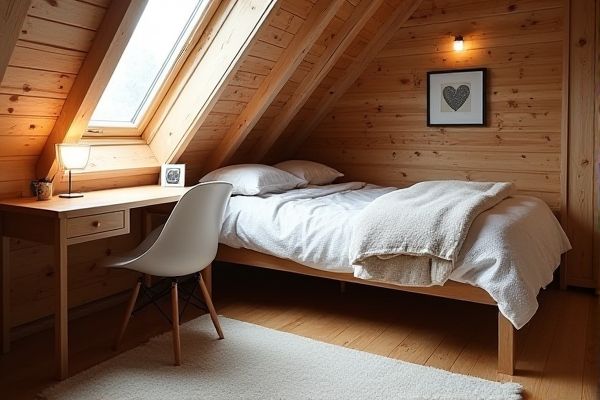
An attic desk bed maximizes small spaces by combining a workspace and sleeping area in a compact, multifunctional unit, ideal for loft or attic conversions. Discover which option best suits your needs and space by reading the rest of the article.
Table of Comparison
| Feature | Attic Desk Bed | Wall Bed |
|---|---|---|
| Space Efficiency | Maximizes vertical space, combines desk and bed in one footprint | Folds vertically into wall, frees floor space when stored |
| Functionality | Integrated desk and bed; ideal for study and sleep | Primarily a bed that folds away; desk may be separate or optional |
| Installation | Requires strong floor or frame support, complex setup | Needs strong wall mounting, professional installation recommended |
| Cost | Moderate to high depending on design and materials | Varies widely; often higher due to folding mechanism and installation |
| Suitability | Best for small rooms with need for multi-use space | Ideal in compact areas needing flexible sleeping solutions |
| Durability | Sturdy structure, less moving parts | Mechanical parts require maintenance, may wear over time |
Overview: Attic Desk Bed vs Wall Bed
Attic desk beds maximize space in loft areas by combining a sleeping surface with a functional desk, ideal for compact environments needing dual-purpose furniture. Wall beds, also known as Murphy beds, save floor space by folding vertically into the wall, offering a seamless blend of bedroom and living room usage. Both designs optimize small living spaces but cater to different spatial configurations and daily routines.
Space-Saving Solutions Compared
Attic desk beds maximize vertical space by integrating workspace and sleeping areas in lofted environments, making them ideal for rooms with high ceilings. Wall beds, or Murphy beds, fold up against the wall, freeing floor space and offering versatile room layouts in compact living areas. Both designs optimize square footage but attic desk beds combine work and sleep functionality, while wall beds prioritize rapid space transformation.
Design and Aesthetics Differences
Attic desk beds maximize space with integrated desks beneath lofted sleeping areas, offering a compact, functional design suited for small rooms or creative workspaces. Wall beds, or Murphy beds, fold vertically into closets or cabinetry, providing a sleek, minimalist aesthetic that seamlessly blends with modern interiors. Your choice depends on whether you prioritize a multi-use workspace or a streamlined, unobtrusive sleeping solution.
Installation Requirements and Flexibility
Attic desk beds require careful assessment of ceiling height, roof structure, and insulation to ensure proper installation and usability, often demanding custom carpentry and reinforcement. Wall beds offer greater flexibility with modular frame options, easier wall mounting, and compatibility with various room layouts, making them suitable for standard walls without major structural changes. Your choice depends on available space and how much modification you're willing to accommodate for either a built-in attic setup or a versatile, space-saving wall-mounted solution.
Functionality: Desk Integration and Utility
An attic desk bed offers exceptional functionality by seamlessly integrating a workspace with a sleeping area, maximizing room usage without sacrificing comfort. In contrast, a wall bed primarily focuses on space-saving by folding away the bed, with limited or no desk integration, making it ideal for rooms where the desk function is separate. Your choice depends on whether you prioritize a combined work-sleep solution or a versatile sleeping space with minimal room footprint.
Comfort and Sleeping Experience
An attic desk bed often provides a more customized sleeping experience by utilizing angled ceilings and maximizing space, allowing for a cozier and quieter environment ideal for restful sleep. Wall beds, or Murphy beds, offer the advantage of easy transformation between a functional workspace and a sleeping area but may compromise on mattress thickness and comfort due to space constraints. Comfort levels in attic desk beds typically exceed those of wall beds, as they allow for more permanent, ergonomic mattress setups tailored to individual sleep preferences.
Storage Options and Organization
Attic desk beds often feature built-in shelves and drawers, maximizing vertical space to keep your belongings neatly organized and easily accessible. Wall beds typically include customizable cabinets and storage compartments around the frame, offering versatile options to store bedding and personal items efficiently. Choosing between the two depends on your available space and storage needs, with attic desk beds providing integrated work and storage areas while wall beds emphasize compact design and hidden storage solutions.
Ideal Room Types and Layouts
Attic desk beds are perfect for sloped ceiling rooms or loft spaces, maximizing vertical space while providing functional work and sleep areas. Wall beds are ideal for small or studio apartments with flat walls, offering a versatile solution that frees up floor space when not in use. Both optimize space in different layouts, with attic desk beds suited for creative designs and wall beds favoring straightforward, compact rooms.
Cost and Budget Considerations
Attic desk beds generally have higher installation costs due to custom carpentry and space-specific adjustments, while wall beds often offer more affordable options with standard sizes and modular designs. Budget-conscious buyers should consider that attic desk beds provide multifunctional use, potentially reducing the need for additional furniture, which can offset initial expenses. Wall beds tend to have lower maintenance costs and easier replacements, making them a cost-effective solution for flexible living spaces.
Pros and Cons: Which Bed Suits Your Needs?
Attic desk beds maximize limited space by combining a workspace and sleeping area, ideal for small rooms or studios, but may have height restrictions and limited comfort compared to traditional beds. Wall beds, also known as Murphy beds, offer versatile use of room space by folding vertically into the wall, perfect for multipurpose rooms, though installation can be costly and the mattress options might be limited. Choosing between the two depends on your room layout, budget, and whether you prioritize integrated storage and workspace or flexible living space.
 homyna.com
homyna.com